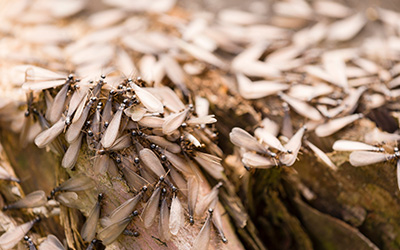
Distinguishing between termites and flying ants, specifically carpenter ants, can pose a significant challenge. Carpenter ants, known for their potential to cause extensive damage, can easily be mistaken for termites due to their appearance and destructive behavior. If you find termites in your home, it’s crucial to understand that they exhibit unique characteristics and behaviors that necessitate specialized treatment methods. At Springer Professional Home Services, our pest control specialists are equipped with the necessary tools and expertise to effectively address and prevent damage caused by either pest.
Identifying Carpenter Ants vs. Termites
To manage infestations of wood-destroying pests effectively, recognizing whether you’re dealing with carpenter ants or termites is essential. Here’s how to differentiate between the two:
- Physical attributes: Compared to termites, carpenter ants are generally larger and have more distinct physical features such as a narrower waist, elongated antennae, and wings of varying sizes. Termites display a more uniform body shape, with less prominent features and wings that are the same size.
- Presence: While termites might remain hidden within your home’s structure for extended periods, carpenter ants are more visible. Signs of their presence include piles of wood shavings where they’ve excavated and discarded wings near entry points.
- Feeding habits: Unlike termites that consume cellulose directly from wood, carpenter ants feed on other insects, including termites, and do not eat the wood while making their tunnels.
Have a pest problem? We can help!
Assessing the Damage: Carpenter Ants vs. Termites
The type of damage caused by these pests can also provide clues to their identity. Carpenter ants tend to target moist or decaying wood initially before moving on to intact wood. While the external damage may not always be apparent, a large number of ants near woodwork can be a significant indicator.
Termites, in contrast, consume the cellulose in wood, leaving behind a distinctive layered appearance. They gain access to homes using mud tubes they construct from the soil, connecting their nests to potential entry points such as basement windows and doors. Carpenter ants leave many visible signals and can be detected early, in contrast, termites stay hidden leading to late detection after damage has already been done. It’s estimated that termite damage amounts to $500 billion annually worldwide.
Solving Your Termite or Carpenter Ant Problem
Should you find yourself facing an infestation of termites or carpenter ants, immediate action is required to mitigate the damage. Engaging in regular inspections by a professional pest control service, such as Springer Professional Home Services, is a proactive measure to protect your home. Our team of exterminators specializes in the detection and prevention of infestations, ensuring your home remains safe from the threat of wood-destroying insects throughout the year. Contact us at Springer Professional Home Services for a free, no-obligation quote!
Back to Termite Exterminators – Control – RemovalTermites vs Flying Ants in Des Moines
Serving Central Iowa since 1989
